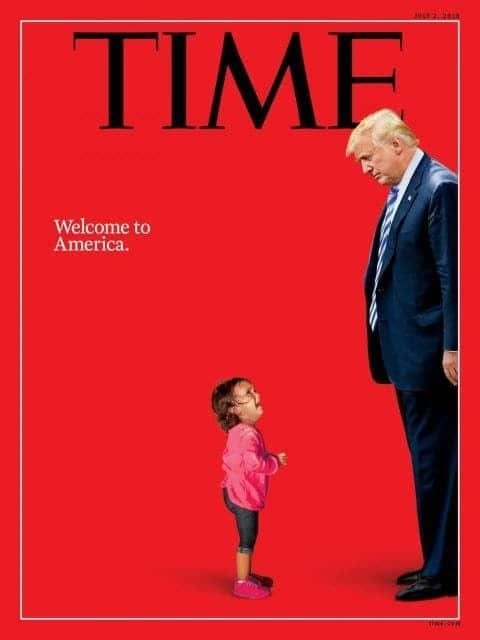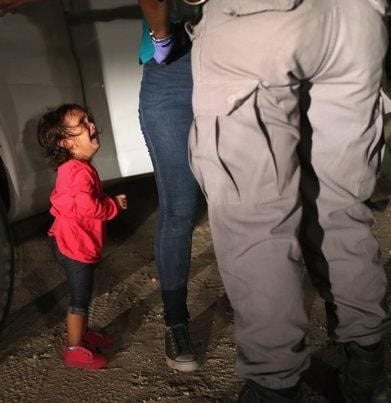
Sharon Lauricella, Ph.D., University of Ontario Institute of Technology

In June 2018, discourse around immigration to the U.S. came to a peak when award-winning Getty Images photographer John Moore captured an image of a distraught, crying, two-year-old Honduran child beside her mother and a U.S. border agent. The image of the toddler, with her shoelaces removed and mouth agape in a wail, came to represent Trump’s “zero tolerance” policy toward undocumented immigrants; thousands of children, parents, and family members were separated at the U.S. border as a form of punishment for attempting to cross illegally. The photo galvanized the public to contact both Republican and Democratic representatives with their objections, and also inspired people to donate to legal defense services for refugees. The emotional photograph had such a significant public impact that shortly after its publication, Trump issued an unusual retreat and ended the hardline policy of separating families.
Just over a week after the photo was taken, and subsequent to its viral spread, Time magazine’s cover of June 21, 2018 featured a photo illustration of the child, without her mother or the border agent, opposite an image of a menacing Trump staring down at her. The caption read, “Welcome to America.”
When Moore took the photo, it was unknown whether the mother, Sandra Sanchez, and her daughter, Yanela, would be separated during the immigration process. Subsequent to the publication of the original photo, it was discovered that the child and her mother were detained without being separated. Carlos Ruiz, the border patrol agent whose legs are in the original photo, told CBS news that upon Sanchez’s illegal crossing, he detained her and her daughter for a formal search, which took “less than two minutes.” Ruiz reported that as soon as the brief search was completed, Sanchez picked up her daughter, who immediately stopped crying.
The Trump administration harshly criticized Time, accusing it of running “fake news” given that the child in the photo illustration and her mother were not separated at the time that the photograph was taken, nor were they separated afterward. Former Speaker of the House Newt Gingrich called for Time to apologize to Trump, and Press Secretary Sarah Sanders tweeted that Democrats and the media were guilty of exploiting the little girl to “push their agenda” to revise Trump’s hardline approach to immigration. Trump also weighed in, tweeting that the Democrats have no intentions of resolving this “decades old problem,” and that “we can pass great legislation [on immigration] after the Red Wave,” referring to the then upcoming elections in November 2018. Other news media outlets argued that printing the photo was a blunder on the part of Time, and that the intended effect of the image “oversold” the problem of families detained and separated at the border.
Time issued a correction which made clear that the child was not taken away from her mother by border agents. However, Time defended its decision to run the cover’s photo illustration, indicating that the image of the distraught child is representative of the thousands of immigrant children separated from their parents and of whom there are not any photographs. Time’s editor-in-chief, Edward Felsenthal, issued a statement arguing that the photo captured the terror of what was indeed happening at the border and in detainee centers:
The June 12 photograph of the 2-year-old Honduran girl became the most visible symbol of the ongoing immigration debate in America for a reason: Under the policy enforced by the administration, prior to its reversal this week, those who crossed the border illegally were criminally prosecuted, which in turn resulted in the separation of children and parents. Our cover and our reporting capture the stakes of this moment.
Felsenthal and those supporting publication of the cover argue that the image of the toddler on its cover was representative of immigration-related political discourse, and that the photo illustration conveyed contemporary treatment of undocumented immigrants. Alongside government-issued photographs of children in cage-like pens in detainee centers, the photo on the cover of Time served as a poignant representation of the difficulties experienced by undocumented immigrants.
Moore is an experienced photojournalist and had covered immigration issues previously. He expressed that he captured a raw and honest image that did much to publicize the terror experienced by many undocumented immigrants. He said he believes that his job as a photojournalist is to inform and report what is happening, and that when he took the photo, he feared that the child and her mother would be separated in the detainment process. Moore also argues that in his work, “it is important to humanize an issue that is often reported in statistics.” He issued no objections to the use of his photograph as it appeared on the Time cover.
Discussion Questions:
- Moore’s photo served to educate and galvanize the public in relation to immigration issues. Does the fact that the toddler was not separated from her mother matter, given that thousands of other children were?
- Viewers of the Time cover could assume that the toddler was separated from her mother while being detained at the U.S. border. Given that this was not the case, should Time have run the cover with the photo illustration featuring this child?
- What ethical values serve as the basis for photojournalism? What interests are often in conflict in photojournalism?
- What values are in conflict in the use of Moore’s photo? How might you best balance the conflicting interests if you were an editor?
Further Information:
Kirby, J. (2018, June 22). “Time’s crying girl photo controversy, explained.” Vox. Retrieved from https://www.vox.com/policy-and-politics/2018/6/22/17494688/time-magazine-cover-crying-girl-photo-controversy-family-separation
Blake, A. (2018, June 22). “Time magazine’s major mistake on the crying-girl cover.” The Washington Post. Retrieved from https://www.washingtonpost.com/news/the-fix/wp/2018/06/22/time-magazines-major-screw-up-on-the-crying-girl-cover/
CBS News. (2018, June 22). “Crying girl in iconic image was never separated from mother, ICE says.” https://www.cbsnews.com/news/border-patrol-agent-involved-dramatic-photo-girl-crying-at-border-speaks-out/
Dwyer, C. (2018, June 22). “Crying toddler on widely shared Time cover was not separated from mother.” NPR. Retrieved from https://www.npr.org/2018/06/22/622611182/crying-toddler-on-widely-shared-time-cover-was-not-separated-from-mother
Holson, L. M. & Garcia, S. E. (2018, June 22). “She became a face of family separation at the border. But she’s still with her mother.” The New York Times. Retrieved from https://www.nytimes.com/2018/06/22/us/immigration-toddler-trump-media.html
Time Staff. (21 June 2018). “The story behind Time’s Trump ‘Welcome to America’ cover.” Time. Retrieved from: http://time.com/5317522/donald-trump-border-cover/
Schmidt, S. & Phillips, K. (2018, June 22). “The crying Honduran girl on the cover of Time was not separated from her mother.” The Washington Post. Retrieved from https://www.washingtonpost.com/news/morning-mix/wp/2018/06/22/the-crying-honduran-girl-on-the-cover-of-time-was-not-separated-from-her-mother-father-says/
This case study can be used in unmodified PDF form for classroom or educational settings. For use in publications such as textbooks, readers, and other works, please contact the Center for Media Engagement.
Ethics Case Study © 2018 by Center for Media Engagement is licensed under CC BY-NC-SA 4.0



